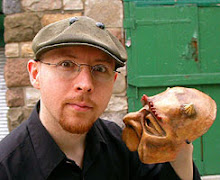Howdy!
A few weeks ago, I made a test to see if I could create a skull cap for a fraction of the cost of the same thing I can purchase in plastic.
"Skull cap" is a term that is nowadays applied to too many things to be of any clear meaning.
The one I am referring to here is a hard cap that is often used in Theatre to create hats and helmets.
I did it to myself!
It worked!
Step one
Cover a bald head with a thick application of aluminum foil.
The thickness becomes the extra space you will have inside the skull cap to install padding.
Which is necessary, for a paper mache skull cap, as sweat would make it uncomfortable and sticky.
Step Two
Remove from head, cover foil cap OUTSIDE with plastic wrap, using masking tape to hold in place.
Step Three:
Cover the OUTSIDE of the foil with paper mache strips.
Check this blog for previous articles about strong paper mache practices.
Basically, you use diluted white glue as a paste, and strong paper, such as thin Kraft paper, which has been softened by crumpling into a ball, soaking in water, and wringing out until no more water comes out. Tear in small pieces, apply over shape, using paste.
Let dry completely.
Step Four
Remove paper mache cast from shape, remove plastic wrap and tape leftovers.
Try it on, trim according to your needs. A skull cap should not irritate or rub against anything, including your ears, horns, or any wonderfully strange bumpŝ you or your customer may have.
Step Five
Strengthen and seal the edges, by adding strong wire on the edges, and covering with paper mache strips (same as described above).
Once dry, this cap will not warp.
Step Six
Now is a good time to sign and date your work with a permanent, preferably lightfast, marker. Make sure you sign and date where there will be no padding added, so that it will always be visible. Seal the whole thing (inside and out) with two coats of water-diluted Weldbond (or diluted white glue, but Weldbond or Sobo are better). Let dry completely.
Step Seven
Install padding. I prefer L200, which is the industry name for the colorful rubber product sold as Fun Foam (or Foamie). This material is easy to cut, glues wonderfully with hot glue, and is sweat-proof.
The pads are small rectangular strips, installed regularly all around the head, but apart from each other, to ensure air and sweat circulation.
Do not add padding where they would touch the temples of the wearer. This would cause headache-inducing pressure.
Step Eight
Install skull cap inside mask or hat, or build mask or hat around it.
I will add pictures of the skull cap one day, when this test is finished. Right now, it's only at step four, and I have no project for it.
I may need it for next Halloween.
Subscribe to:
Post Comments (Atom)



No comments:
Post a Comment